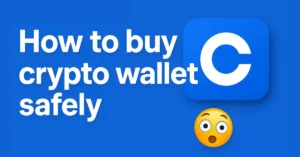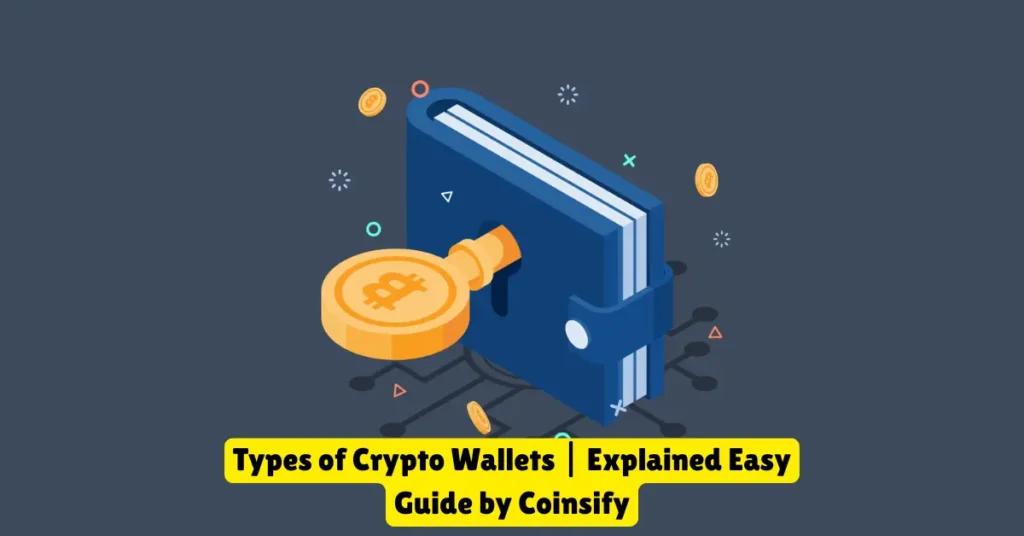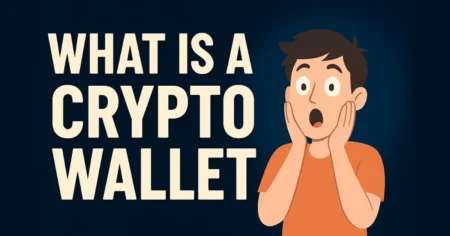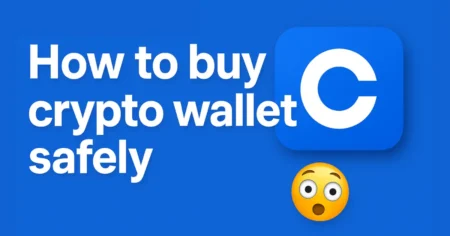Introduction
As cryptocurrencies like Bitcoin and Ethereum continue to grow in popularity, more and more people are looking for safe and simple ways to store their digital assets. Just like we keep money in a wallet or bank, cryptocurrencies need a special place for storage too and that’s where crypto wallets come in.
There are many types of crypto wallets available, each with its own features, benefits, and security levels. Whether you’re new to crypto or already trading, it’s important to understand the different wallet types so you can protect your coins properly.
In this guide by Coinsify, we’ll explain what a crypto wallet is, explore the different types, and help you choose the right one for your needs all in a way that’s easy to understand, even if you’re just getting started with crypto.
What Are the Types of Crypto Wallets?
Crypto wallets come in different forms, but they all serve the same basic purpose: to store your private keys and give you access to your cryptocurrencies. The two main types of crypto wallets are hot wallets and cold wallets. These are further divided into several subtypes based on how you plan to use them and how secure you want your crypto to be.

Let’s break down each type in a simple and clear way:
Hot Wallets
Hot wallets are connected to the internet, which makes them easy to access and perfect for frequent transactions. However, this also means they are slightly more exposed to online threats like hacking or malware.
The most common types of hot wallets are:
- Desktop Wallets: Installed on your computer and give you full control. Good for personal use, but risky if your device gets a virus.
- Mobile Wallets: Apps on your smartphone. They’re great for quick and everyday transactions.
- Web Wallets: These run in your browser and are hosted by a third party, like crypto exchanges. Convenient, but your security depends on the platform’s safety.
Cold Wallets
- Cold wallets are not connected to the internet, making them much safer from online attacks. They are best for long-term holders who don’t need regular access to their crypto.
Here are the main types:
- Hardware Wallets: Physical devices (like USB drives) that store your private keys offline. They are one of the safest ways to store crypto.
- Paper Wallets: A printed or handwritten version of your public and private keys. Very secure if kept safe, but risky if lost or damaged.
Each type of wallet has its pros and cons. Some are designed for speed and convenience, while others focus on security and long-term storage. At Coinsify, we always recommend choosing a wallet based on your personal needs and how you plan to use your crypto.
Why Understanding Crypto Wallet Types Is Important
Knowing the different types of crypto wallets is not just technical knowledge it’s essential for protecting your digital assets. Whether you’re holding a small amount of cryptocurrency or building a serious portfolio, using the right wallet can make a big difference in terms of security, convenience, and control.

Here’s why this knowledge matters:
Protects You from Hacks and Theft
- Some wallets are more secure than others, especially those not connected to the internet.
- Choosing a safe wallet reduces the risk of losing your crypto to hackers or phishing attacks.
Helps You Choose the Right Wallet for Your Needs
- Are you a frequent trader or a long-term holder?
- Understanding wallet types helps you pick one that fits your lifestyle whether it’s a mobile wallet for quick access or a hardware wallet for long-term safety.
Gives You Full Control Over Your Crypto
- With non-custodial wallets, you hold the private keys not an exchange or a third party.
- This means you have full ownership and aren’t relying on someone else to keep your funds safe.
Saves You from Costly Mistakes
- Many new users lose access to their coins due to poor wallet choices or not backing up keys.
- Learning about wallets early helps you avoid these common and often irreversible mistakes.
Builds Your Confidence in Using Crypto
- When you understand how wallets work, you feel more confident making transactions and exploring new crypto opportunities.
- This is especially important if you’re planning to use platforms like Coinsify for trading or investing.
Understanding crypto wallets is one of the first and most important steps in your crypto journey. The more you know, the safer and smarter your decisions will be.
Step-by-Step Guide to Understanding Types of Crypto Wallets
If you’re new to the world of crypto, choosing the right wallet might feel confusing. But don’t worry here’s a step-by-step guide that breaks it down in a clear and straightforward way.

Step 1: Understand What a Crypto Wallet Really Is
- A crypto wallet doesn’t actually store coins, but stores your private and public keys, which are used to access and manage your cryptocurrency.
- Without a wallet, you can’t send, receive, or store crypto securely.
Step 2: Learn the Two Main Categories
Crypto wallets are divided into two main types based on internet connectivity:
- Hot Wallets: Connected to the internet.
- Cold Wallets: Offline and not connected to the internet.
Each type has different use cases and security levels.
Step 3: Explore Hot Wallets (For Active Users)
Hot wallets are ideal if you:
- Make frequent trades or transfers.
- Need fast access to your funds.
Types of Hot Wallets:
- Desktop Wallets: Software you download on your computer. Secure but vulnerable if your PC gets infected.
- Mobile Wallets: Apps on your phone. Easy to use for daily transactions.
- Web Wallets: Run in browsers and are managed by platforms like exchanges. Very convenient, but depend on the site’s security.
Step 4: Explore Cold Wallets (For Long-Term Holders)
Cold wallets are better if you:
- Want high-level security.
- Don’t need to access your crypto often.
Types of Cold Wallets:
- Hardware Wallets: Physical devices (like USB drives) that keep your keys offline.
- Paper Wallets: A printed copy of your keys. Not very common now, but very secure if stored safely.
Step 5: Understand Custodial vs. Non-Custodial Wallets
- Custodial Wallets: A third party (like an exchange) holds your keys.
- Easy to use but less control.
- Non-Custodial Wallets: You manage and store your keys yourself.
More secure and gives you full ownership.
Step 6: Choose the Right Wallet Based on Your Needs
Ask yourself:
- Do I trade daily or just want to hold?
- Am I comfortable managing my own keys?
- Do I prefer convenience or security?
Match your needs with the right wallet type. For example:
- Daily trader: Mobile or web wallet.
- Long-term investor: Hardware wallet.
Step 7: Take Security Precautions
- Always back up your wallet.
- Keep your private key secret.
- Use two-factor authentication when possible.
- Be careful with phishing links and unknown websites.
This step-by-step guide will help you confidently choose the right type of crypto wallet. And remember, if you’re using platforms like Coinsify, they often give you access to built-in wallets just make sure to understand if it’s custodial or not.
Frequently Asked Questions (FAQs) About Crypto Wallets
What is the safest type of crypto wallet?
The safest type of crypto wallet is a hardware wallet, which is a form of cold storage. It keeps your private keys completely offline, making it nearly impossible for hackers to access your funds. Since it’s not connected to the internet, it’s highly secure — even if your computer or mobile device gets hacked. However, it’s important to keep the device safe and not lose your recovery phrase, or you could lose access to your funds forever.
Can I use more than one type of wallet at the same time?
Yes, you can! Many crypto users have more than one wallet. For example, you can use a mobile wallet for daily spending and quick access, and a hardware wallet for saving your crypto securely for the long term. This approach gives you both convenience and security. Just make sure you keep track of your wallets and back up your private keys or recovery phrases.
What happens if I lose my crypto wallet?
If you lose your crypto wallet especially a hardware or software wallet you can still recover your funds as long as you have your recovery phrase or private key. These are like backup keys to your wallet. That’s why it’s very important to write them down and store them in a safe place. If you lose both the wallet and the recovery key, there’s usually no way to get your crypto back.
What is the difference between hot and cold wallets?
Hot wallets are always connected to the internet. They’re great for quick access and easy to use, but they’re more vulnerable to online threats.
Cold wallets are completely offline. They’re much safer from hacking, but not as convenient for daily use.
If you’re a regular trader, a hot wallet might work for you. If you’re holding crypto as a long-term investment, cold wallets are a better choice.
Are crypto wallets free to use?
Most crypto wallets especially mobile, desktop, and web wallets are free to download and use. However, you might pay network fees (called gas fees) when sending crypto, which are not charged by the wallet provider but by the blockchain network.
Hardware wallets, on the other hand, are physical devices that you need to buy, and their prices usually range from $50 to $200, depending on the brand and features.
Is it safe to keep my crypto on an exchange wallet?
Keeping your crypto on an exchange wallet (like Binance or Coinbase) is convenient, but it’s not the safest option. These are custodial wallets, meaning the exchange controls your private keys. If the exchange gets hacked or shuts down, you could lose your funds.
For better security, transfer your crypto to a non-custodial wallet where only you have access to the keys. Remember the popular phrase in crypto: “Not your keys, not your coins.”
What is a private key, and why is it important?
A private key is like a password that gives you access to your crypto. Whoever has the private key can control the funds in the wallet. That’s why you should never share it with anyone. If someone else gets your private key, they can easily take your crypto, and you won’t be able to recover it.
Always back up your private key or recovery phrase and keep it safe offline.
Which wallet should beginners use?
For beginners, a mobile wallet is a great starting point. It’s easy to install, simple to use, and works just like a regular app. Some beginner-friendly wallets also include features like built-in exchanges, price tracking, and tutorials.
Once you’re more comfortable with crypto, you can move your coins to a hardware wallet for extra safety.
Do I need the internet to use a crypto wallet?
It depends on the type of wallet:
Hot wallets (mobile, web, desktop) need an internet connection to send and receive crypto.
Cold wallets (hardware, paper) don’t need the internet to store your coins, but you’ll need to connect them briefly when you want to make a transaction.
For maximum security, cold wallets are often kept completely offline until needed.
Can I store all cryptocurrencies in one wallet?
Not always. Some wallets support multiple cryptocurrencies, while others are designed for specific coins. For example, a Bitcoin-only wallet won’t support Ethereum or other tokens.
If you want to manage several types of coins in one place, choose a multi-currency wallet. Make sure to check the wallet’s website or app store description to see which coins it supports.
Conclusion
Choosing the right crypto wallet is an important step in keeping your digital assets safe. Whether you go with a hot wallet for easy access or a cold wallet for strong security, it all depends on how you plan to use your crypto. Take your time, understand your options, and always keep your private keys safe. With the right wallet and a little care, you can manage your crypto with confidence.
Bonus Points: Extra Tips for Managing Your Crypto Wallet Safely and Smartly

Always Back Up Your Wallet Properly
One of the biggest mistakes crypto users make is not backing up their wallet. When setting up a wallet, you’ll receive a recovery phrase (also called a seed phrase). This phrase is the only way to recover your crypto if your device is lost, stolen, or damaged.
- Write it down on paper never store it digitally or online.
- Make multiple copies and store them in different secure places (like a safe or lockbox).
- Never share your recovery phrase with anyone.
This one step can protect you from total loss.
Stay Updated With Wallet Software and Security Features
Just like apps and software, wallet providers release updates to fix bugs, improve security, and add new features. Make it a habit to:
- Regularly update your wallet app or desktop software.
- Check for new security settings (like 2FA or biometric login).
- Follow the official channels of your wallet provider for news and alerts.
Staying updated helps you stay protected.
Beware of Fake Wallets and Scams
There are many fake wallet apps and websites out there that look real but are designed to steal your crypto. Before downloading or using any wallet:
- Only download from trusted sources like official websites or verified app stores.
- Double-check URLs scammers often use similar-looking domains.
- Read user reviews and check ratings before installing any wallet app.
Taking these precautions can save you from costly mistakes.
Use Multi-Signature Wallets for Extra Security
For advanced users or businesses handling large amounts of crypto, consider using a multi-signature (multi-sig) wallet. These wallets require more than one private key to approve a transaction, like having two or three people sign off before funds can be moved.
- Great for shared wallets, teams, or partnerships.
- Adds an extra layer of protection against unauthorized access.
It may seem technical at first, but it’s a powerful tool for added security.
Don’t Store All Your Crypto in One Wallet
Just like the saying “don’t put all your eggs in one basket,” it’s smart not to keep all your crypto in a single wallet especially if it’s a hot wallet.
Here’s a better strategy:
- Use a hardware wallet for large savings (cold storage).
- Use a mobile or desktop wallet for regular transactions (hot wallet).
- Keep a small amount on exchange wallets only if needed for active trading.
This way, if one wallet is compromised, your entire portfolio won’t be at risk.
Understand Blockchain Fees Before Sending Funds
Every time you send cryptocurrency, you might have to pay transaction (network) fees. These are not wallet fees they’re paid to the blockchain network to process your transaction.
- Fees vary depending on the network (Bitcoin, Ethereum, etc.).
- Check the fee before sending, especially during busy times.
- Some wallets let you choose the speed (and cost) of your transaction.
Understanding this helps you avoid overpaying or wondering where your coins went.
Educate Yourself Before Using Advanced Wallet Features
Some wallets offer features like staking, token swaps, DApp access, and NFTs. These are useful but can be risky if you don’t understand them.
- Read about any feature before using it.
- Start small and test features on low amounts first.
- Use trusted platforms like Coinsify if you’re exploring crypto tools and trading.
Being informed keeps you in control of your funds.
These bonus points add practical value for both new and experienced users, helping them not just choose the right wallet but also use it smartly and securely.
Also read
- What is a Crypto Wallet and How Does It Work? – Coinsify
- 10 Crypto Terms Every Beginner Must Know – Coinsify
- What is Blockchain Technology – Complete Guide – Coinsify
- How to Buy Crypto Safely in 2025 – Complete Guide – Coinsify
- Bitcoin vs Ethereum: Key Differences Explained – Complete Guide
- Ultimate Blockchain Glossary: Learn Blockchain Terms Easily
- How to Buy Bitcoin Safely (Complete Beginner’s Guide)
- Top 10 Crypto Wallets for Beginners (2025 Edition)
- What is Cryptocurrency? A Beginner-Friendly Guide (2025)






